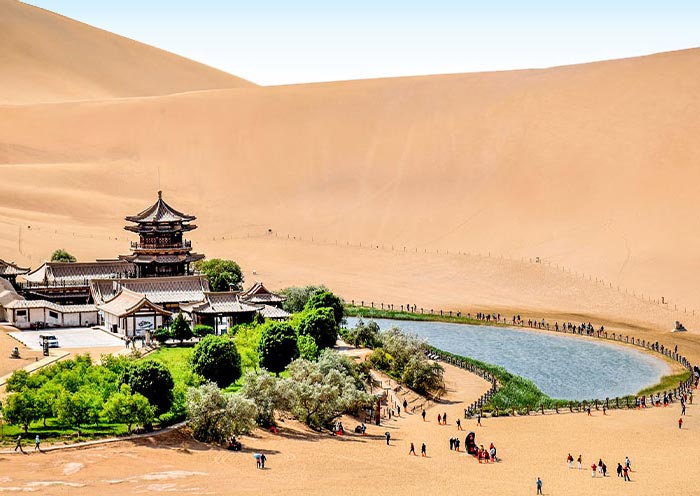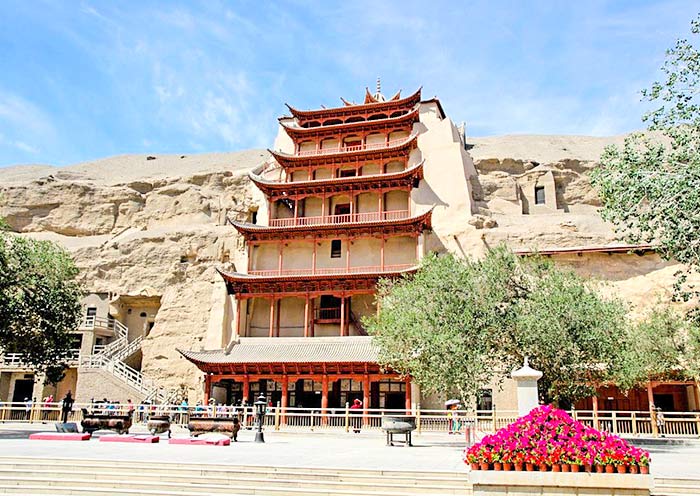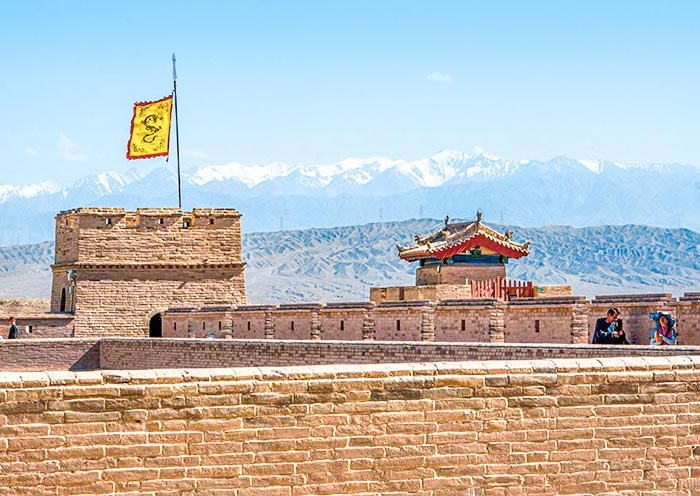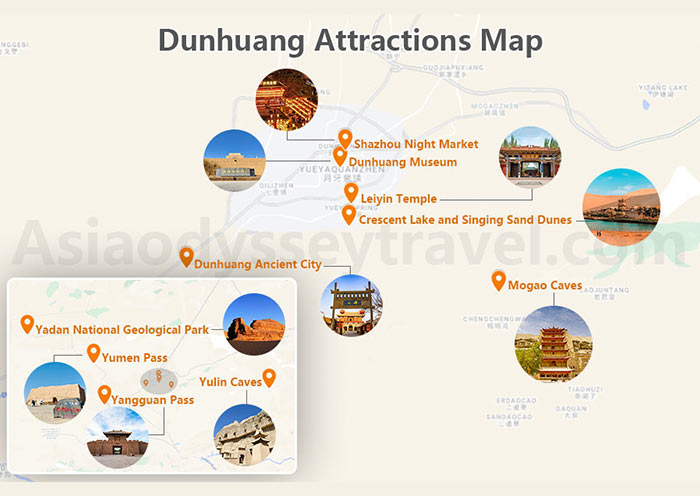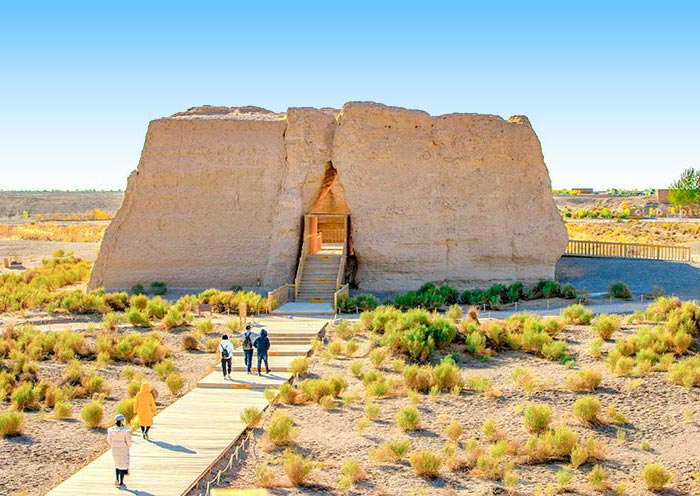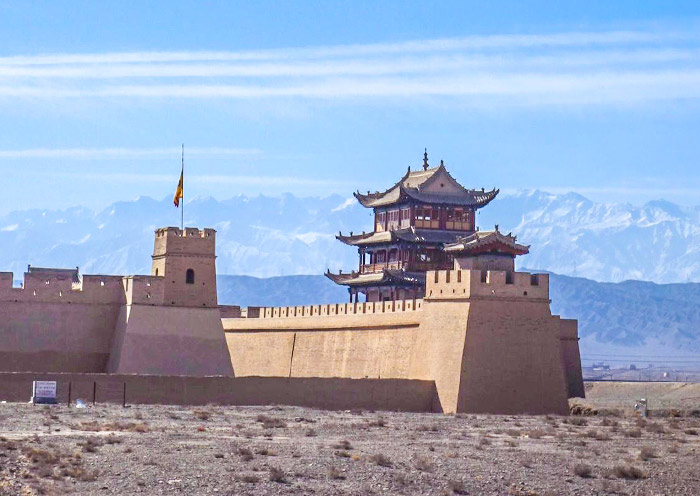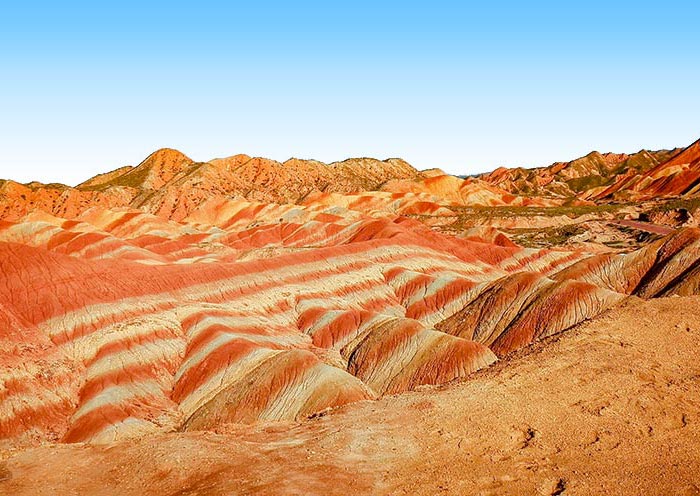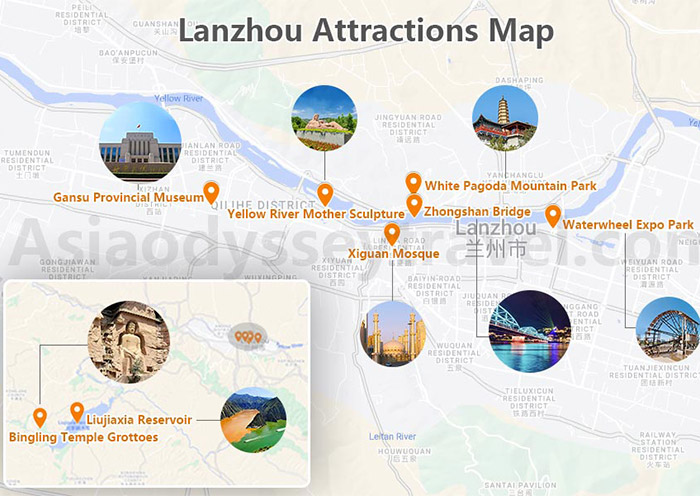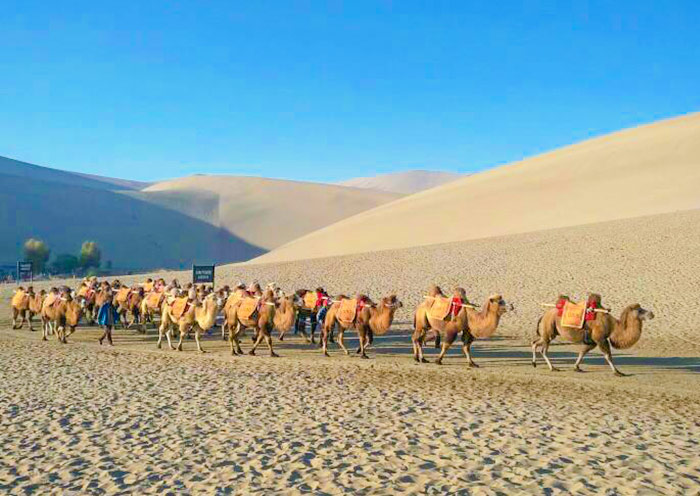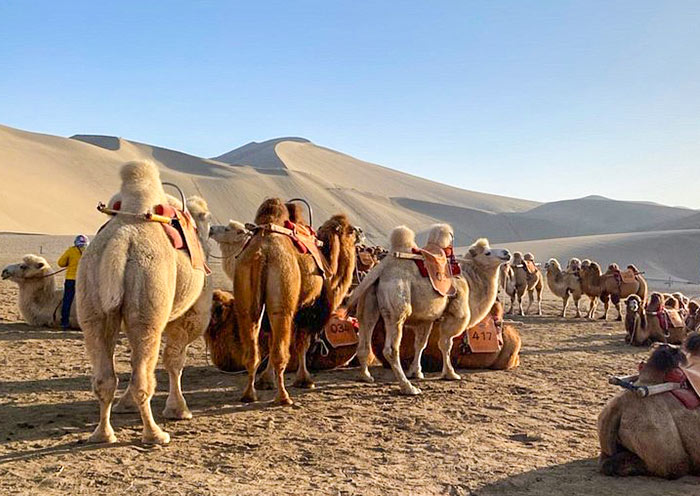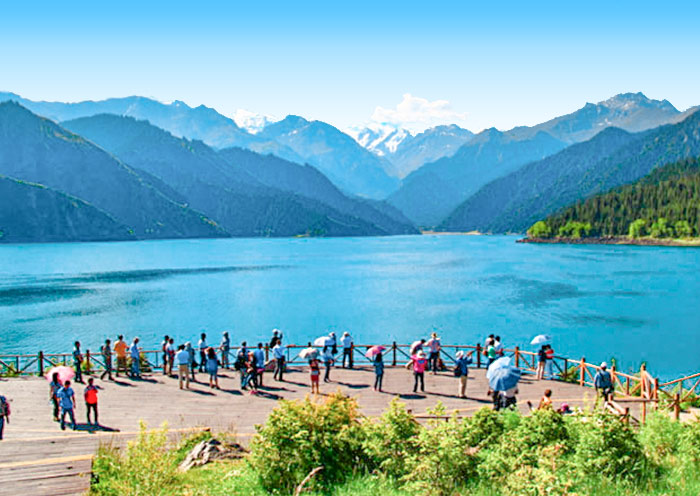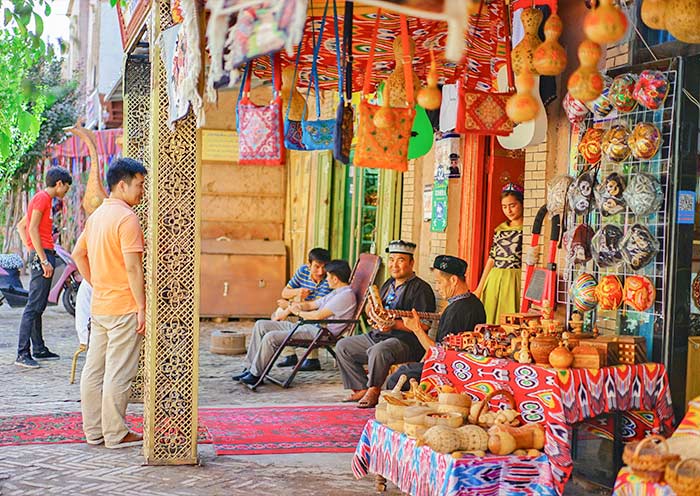Mogao Caves Facts
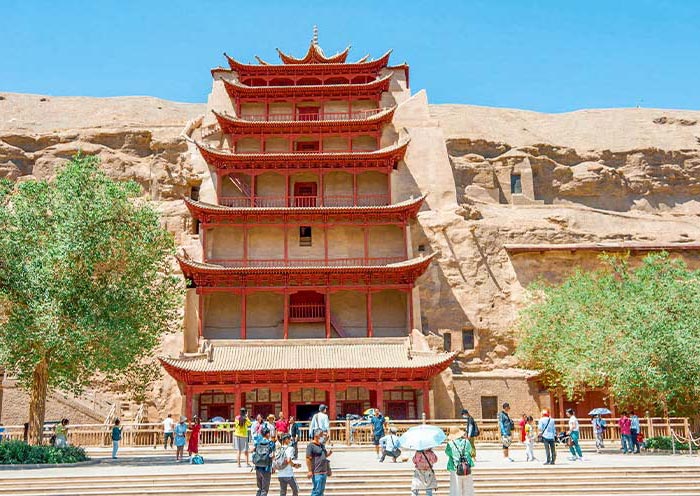
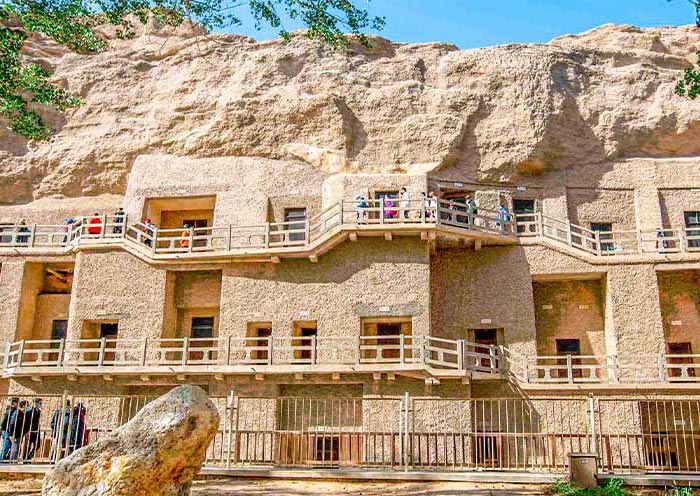
Location: Dunhuang, Gansu Province, Northwestern China
Number of Caves: 735 caves
Highlights: Buddhist murals, painted sculptures, the Library Cave, and the Thousand Buddha motifs
Best Time to Visit: April - October
Opening Time: Daily from 9:00 am to 5:30 pm (hours may vary seasonally)
Recommended Visiting Time: 0.5-1 day, to explore several caves and exhibits
Tickets: Approximately 160-258 RMB, depending on season and cave access
Who First Carved the Mogao Caves?
Legend has it that in 366 AD, a monk named Le Zhan was passing by the Mingsha Sand Dunes near Dunhuang when he saw a vision of a thousand Buddhas. Believing this was a sacred site for Buddhism, he decided to recreate the extraordinary scene he witnessed. So, he gathered a group of people and started carving out the first cave at what would become the Mogao Caves.
Why Were the Mogao Caves Carved Continuously over a Thousand Years?
From the Northern Dynasties to the Yuan Dynasty, the Mogao Caves were continuously carved for about 1,000 years across ten dynasties. The prosperity of the Silk Road was undoubtedly the main reason for this ongoing work. Back then, merchants traveling through Dunhuang into the Xinjiang region faced the daunting Taklamakan Desert, the second-largest desert in the world. To ensure a safe and smooth journey, these traders would often pray at the Buddhist sites in Dunhuang for protection.
Many even donated money to build Buddha statues and caves as offerings to the deities. It wasn't just the merchants; locals, influential families, and politicians also joined in on creating their own caves. Over time, more and more people began carving caves in Dunhuang, leading to larger and more elaborate structures.
How Many Caves are there in Mogao?
The Mogao Caves stretch over 1,600 meters in length and are arranged in five tiers, resembling a spectacular beehive. There are currently 735 caves in total, divided into two main areas: the south and the north. The southern area has 492 caves that serve as places for worship, while the northern area, with 243 caves, is primarily where monks practice and live.
Mogao Caves History
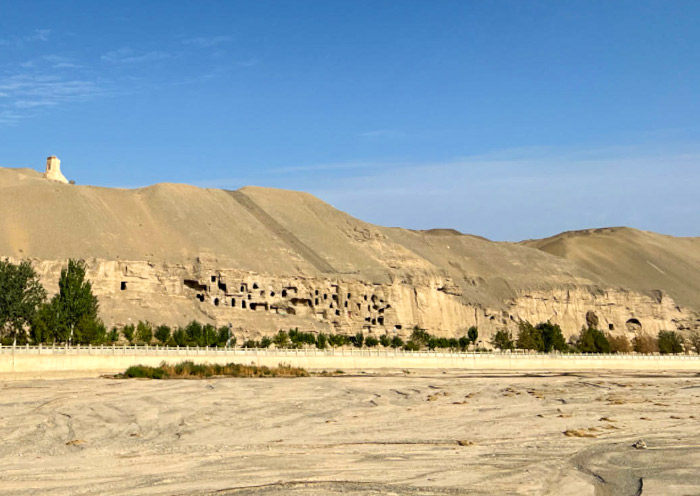

Origins (366 AD): In 366 AD, a monk named Le Zhan gathered people to carve out the first cave, marking the beginning of a long-standing tradition. You can really see the influence of Indian cave art in the early designs.
Sui and Tang Dynasties (Golden Age): The Sui and Tang Dynasties were the peak years for the Mogao Caves. During the Tang Dynasty, the sculptures took on a more realistic and individualized style, breathing life into the clay figures. This was a time when Dunhuang art transformed, becoming more Chinese and relatable, with artistic techniques reaching unprecedented heights. The murals from this period are absolutely breathtaking.
Decline and Rediscovery: By the 14th century, the importance of the Silk Road began to wane, which led to less maintenance of the caves. They were mostly forgotten until 1900 when a Taoist monk named Wang Yuanlu discovered the hidden "Library Cave," filled with thousands of ancient documents and manuscripts.
UNESCO World Heritage Site: In 1987, the Mogao Caves were designated a UNESCO World Heritage site due to their historical, cultural, and artistic significance. They've truly become the superstar of the Silk Road!
Why Visit Mogao Caves? What makes Dunhuang Mogao Grottoes so famous?
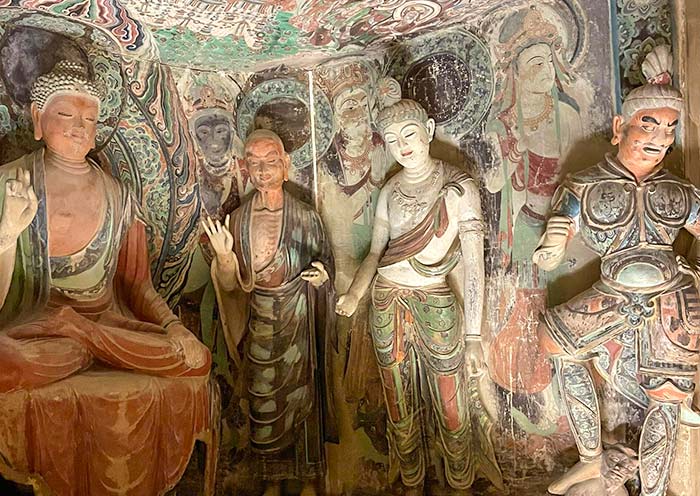
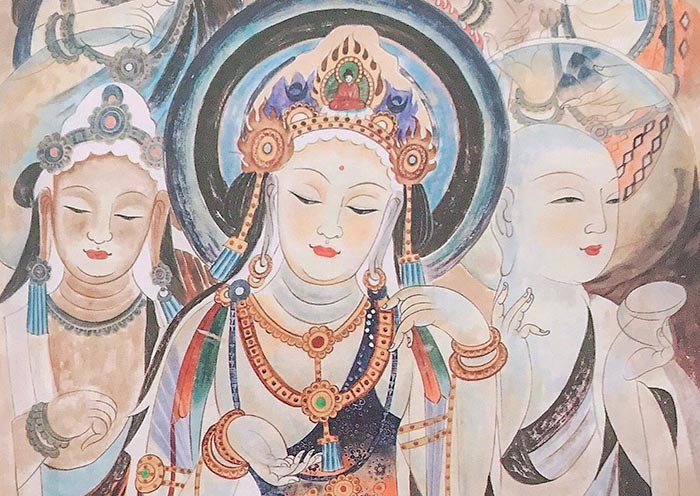
Over 45,000 Square Meters of Stunning Murals
The Mogao Caves are one of the world's finest sources of Buddhist art. You'll find murals in almost every cave and on every wall, filled with rich imagery featuring Buddhas, celestial beings, flying figures, and musicians. There are also story-telling murals that illustrate Buddhist scriptures and the development of Buddhism itself.
Variety of Cave Architecture
These caves showcase a range of architectural designs that reflect their time and purpose. For example, the Nirvana Caves (148/158) are famous for their serene depictions of the Buddha in meditation. The Central Pillar Caves (428) have striking structural elements that enhance their spiritual atmosphere, while the Temple Caves (249) serve as spaces for worship and reflection, demonstrating the diversity of Buddhist practices over the centuries.
Library Cave
A highlight of any visit is the Library Cave, where thousands of hidden manuscripts and artifacts were discovered. This cave offers a fascinating glimpse into the past, showcasing invaluable documents about Buddhism, art, and history that reveal the significance of the region.
Painted Clay Sculptures
The caves also house a remarkable collection of clay sculptures, including over 3,000 painted figures such as Buddhas, Bodhisattvas, and guardian deities. These statues are crafted with wooden frames and colorful clay, featuring intricate details that highlight the artistic skills of the time.
Which Caves in Mogao Grottoes to Visit

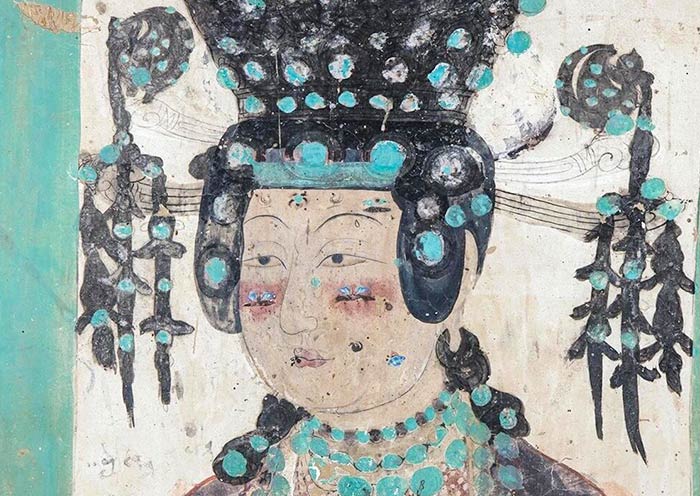
Cave 45: This cave features stunning sculptures from the flourishing Tang Dynasty, including a Bodhisattva statue that's often hailed as the most beautiful one. With lowered brows, gentle eyes, and a subtle smile, it truly captures the essence of grace.
Cave 57: Known for telling the stories of "Riding an Elephant into the Womb" and "Crossing the City at Midnight," this cave has vivid murals, including a hand holding a lotus flower on the back wall that really brings the scenes to life.
Cave 275: This cave boasts the tallest statue from the Northern Dynasties, with a 3.34-meter-tall Bodhisattva statue in the central wall. It's a breathtaking sight!
Cave 156: Inside this cave, you can find a precious mural depicting General Zhang Yichao's military expedition, which gives a deep sense of history and significance.
Cave 158: Known as the Great Buddha Cave, it features a standing statue of the Past Buddha on the left and a seated statue of the Future Buddha on the right. The murals on three walls depict beings listening to the teachings after the Buddha's Nirvana.
Cave 159: This cave showcases impressive original sculptures from the Mid-Tang period, featuring Ananda and a vibrant Bodhisattva. The eastern wall's mural of the Vimalakirti Sutra beautifully recreates scenes of ancient life.
Cave 220: From the Early Tang period, this cave features murals of seven Medicine Buddhas, dancers in Hu Xuan, and scenes from the Vimalakirti Sutra, representing the pinnacle of Tang Buddhist art.
Cave 61: Famous for its murals depicting the sacred site of Wutai Mountain's Manjushri Bodhisattva, this cave illustrates all the famous temples from Wutai Mountain. It was through these murals that Lin Huiyin and Liang Sicheng were eventually able to locate Shanxi's Giant Buddha Temple, the oldest existing Tang Dynasty structure in China.
Cave 148: Also known as the Nirvana Cave, this is the largest sculpture of Shakyamuni's Nirvana in the Mogao Caves, dating back to the Tang Dynasty.
How to Visit Mogao Caves in Dunhuang?
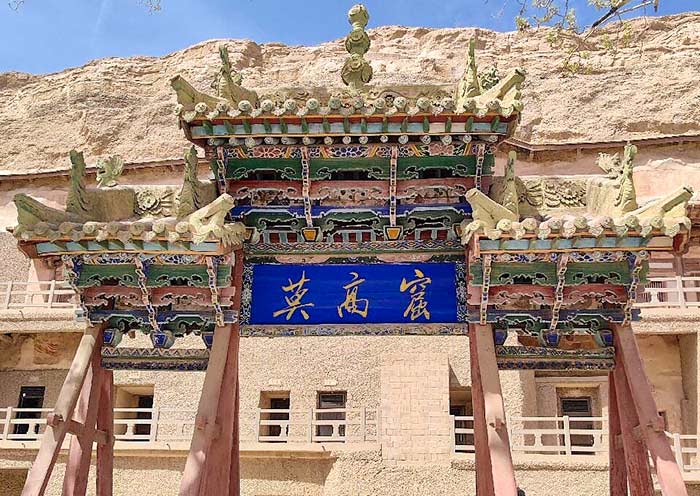
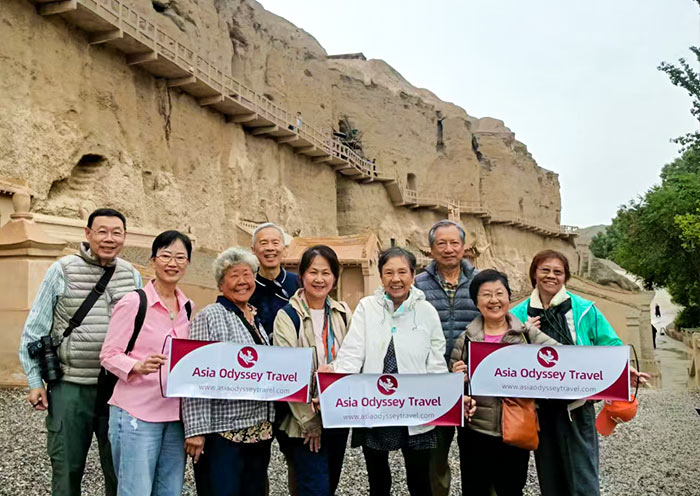
When visiting the Mogao Caves, you actually need to check out two main spots: the Mogao Caves Digital Exhibition Center and the Mogao Caves Scenic Area. They're about 16 kilometers apart, and you can easily get between them using the shuttle buses provided in the area.
Mogao Caves Digital Exhibition Center - Your Start Point
The Mogao Caves Digital Exhibition Center, located about 10 kilometers northwest of downtown Dunhuang, is your first stop when visiting the awe-inspiring Mogao Caves. Here, you'll kick off your journey with two incredible films totaling around 40 minutes: "A Millennium at Mogao" and "The Fantasy Buddha Palace."
"A Millennium at Mogao" dives into the rich history of the Mogao Caves, bringing to life the stories carved into its walls over centuries. Then, "The Fantasy Buddha Palace" brings you up close to some of the site's most famous cave paintings and sculptures, like the giant Buddha of the Nine Levels, which you can only gaze up at from below in person. This dome-screen movie lights up these artworks in vivid detail, allowing a brighter and clearer view than you'd get inside the dimly lit caves. For the best viewing experience, make sure to grab a seat in the back row—you won't regret the enhanced perspective it offers!
Mogao Caves (8 or 12 Caves)
After the movie wraps up, you can hop on a shuttle that'll take you straight to the entrance of the Mogao Caves (about 16 km). Tours are typically grouped into about 15-20 people, led by a guide. During peak season, you'll explore 8 standard caves, while in the off-season, you get to check out up to 12. Key highlights include Cave 16-17 (the Library Cave) and Cave 96 (the Giant Buddha Cave) - these are must-sees!
Special Caves: Once you've toured the standard caves, you have the option to explore some special caves for an additional fee of about 150-200 yuan each. Just a heads up, tickets for these special caves can only be purchased on-site, and if you arrive later in the day, there's a good chance they might already be sold out. So, if you're keen on seeing these extra-special spots, getting there early is your best bet!
Mogao Museums - Photo Spot
At the Mogao Caves Scenic Area, you can explore various museums, including the Sutra Cave Exhibition Hall and the Display Center, all of which are perfect for photography. While many items in the Sutra Cave Exhibition Hall are replicas, the Display Center features impressive 1:1 scale reproductions of 8 actual caves. These replicas, including caves 003, 217, 276, 419, 285, 249, 275, and Yulin Cave 29, perfectly capture the original size, decoration, sculptures, and murals. Even though they are replicas, they offer a fantastic glimpse into the artistry and history of the Mogao Caves, making them well worth a visit!
Dunhuang Mogao Caves Tickets
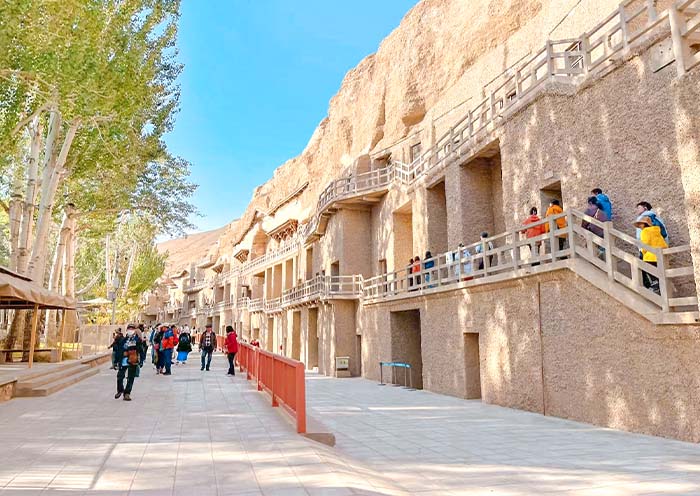

Ticket Types and Prices
- General Admission:
- Standard Ticket: Includes access to the Digital Exhibition Center and a guided tour of the caves.
- Price: Approximately 258 RMB during peak season (May to October); 160 RMB during the off-season (November to April).
- Special Caves Ticket:
- After touring the general caves, you have the option to visit special caves that require an additional ticket.
- Price: Around 150-200 RMB per cave, depending on the cave.
Booking Your Tickets
Daily Ticket Cap: Every day, only 6,000 tickets are up for grabs, so plan accordingly!
Advance Booking: During the peak season, make sure to book your tickets at least 7 days ahead.
All-Inclusive Price: The ticket price covers your shuttle transport within the site and the cost of a guided tour—no extra fees!
Special Caves Tickets: Want to explore the special caves? Those tickets can only be purchased on-site, so get there early to snag one.
How to Get to Mogao Caves in Dunhuang
Mogao Caves Lacation: How to Get to Mogao Caves in Dunhuang

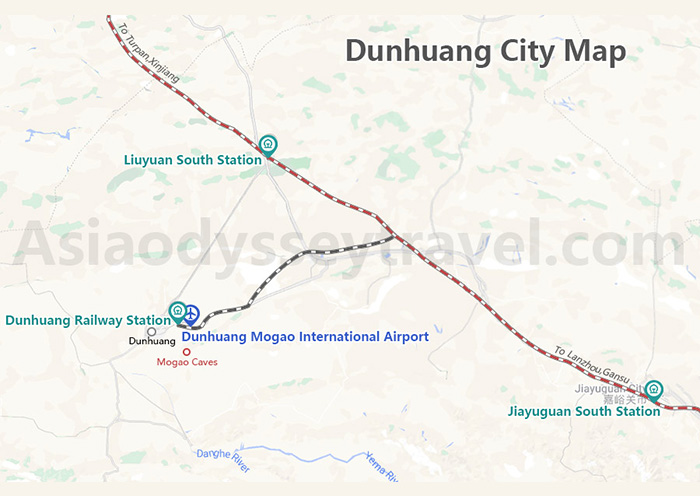
The Mogao Caves are located near Dunhuang in Gansu Province, in the northwestern part of China. Situated at the edge of the Gobi Desert, this remarkable site is part of the ancient Silk Road, where it served as a center for Buddhist art and cultural exchange for over a thousand years. The caves are about 25 kilometers (15.5 miles) southeast of Dunhuang city, easily reachable by road.
Traveling to Dunhuang
First, you'll need to reach Dunhuang. The city is accessible by:
Air: Fly into Dunhuang Airport from major Chinese cities like Beijing, Shanghai, Xi'an, and Chengdu. The airport is about 13 kilometers from the city center.
Train: Dunhuang is also reachable by train, though it may be a longer journey depending on your starting point. The city's train station is located about 12 kilometers from the city center.
Bus: Long-distance buses connect Dunhuang with other cities in Gansu Province and neighboring regions.
From Dunhuang to Mogao Caves
Once you're in Dunhuang, you have a few options to reach the Mogao Caves:
Tour Bus: The most convenient way to visit the Mogao Caves is by tour bus, which departs from the Dunhuang Hotel on Mingshan Road. These are specifically aimed at tourists heading to the caves.
Taxi or Ride-Share: You can easily catch a taxi or use a ride-sharing service. The drive from Dunhuang city center to the Mogao Caves takes about 20 minutes.
Public Bus: Public bus No. 12 runs from the city center to the Mogao Caves. It's the most economical option but also the least convenient in terms of travel time and comfort.
How to Plan a Dunhuang Mogao Caves Tour
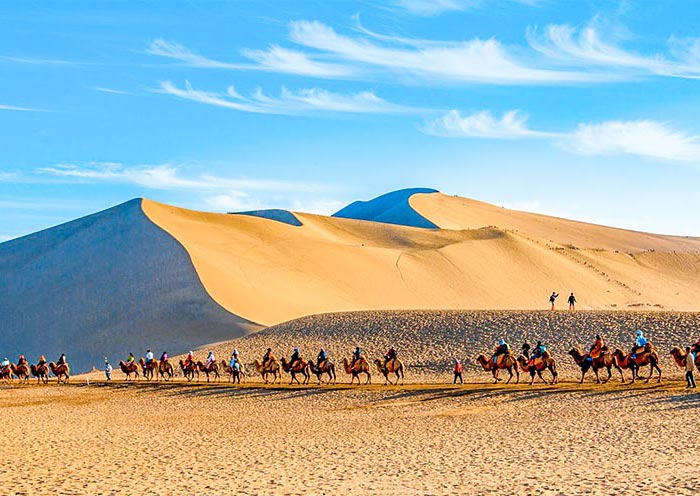
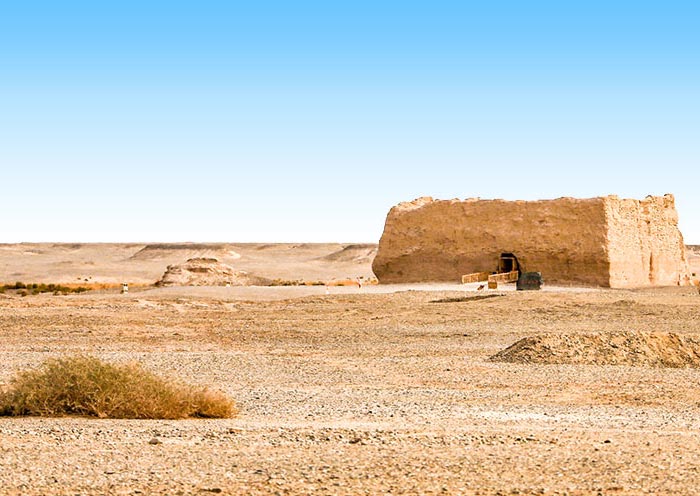
Visiting the Mogao Caves in Dunhuang typically takes around half a day. If you want to explore some special caves as well, your visit might extend to about 6-8 hours, depending on how many you choose to see. After your visit, you can head over to the nearby Mingsha Mountain and Crescent Lake for a stunning experience.
Suggested Dunhuang Itinerary Over Three Days:
Day 1: Settle into Dunhuang upon arrival.
Day 2: Delving into Dunhuang - Engage deeply with the ancient art at the Mogao Caves. Later, explore the natural resonance of Mingsha Mountain and enjoy the peaceful ambiance at Crescent Lake.
Day 3: Tracing History in Dunhuang - Discover the expansive landscapes of Yadan National Geopark, explore the historical depth at Yumen Pass, and walk along the ancient Han Dynasty Great Wall.
In-Depth Exploration of the Gansu Silk Road


Travel Through Gansu (6-8 Days)
Exploring Lanzhou: Allocate 1-2 days to immerse in the cultural vibrancy of Lanzhou, sampling its historical layers and local delicacies like the renowned beef noodles.
Visiting Zhangye: Reserve 1-2 days to witness the awe-inspiring Danxia Landform, a natural spectacle of multicolored rock formations.
Venturing into Jiayuguan: Spend 1-2 days at Jiayuguan, where the ancient fort marks the frontier of the Great Wall during the Ming dynasty.
Extended Travels in Xinjiang & Qinghai
Journey through Xinjiang (7-8 Days): Consider a comprehensive 7-8 day tour of Xinjiang, starting in the lively Urumqi. Proceed to the historical Turpan, the culturally diverse Kashgar, the secluded Tashkurgan, and conclude with the untouched natural beauty of Kanas Lake.
Discovering Qinghai (1-3 Days): Extend your itinerary to include Xining in Qinghai, where you can visit the eminent Kumbum Monastery and unwind by the tranquil Qinghai Lake.
Travel with Asia Odyssey Travel (AOT) to Explore Dunhuang, Gansu
Travel to Dunhuang with Asia Odyssey Travel (AOT) and discover the stunning treasures of the Silk Road in Gansu, China. With years of expertise in crafting tours in Northwestern China, AOT offers a variety of customizable tour packages that cater to all types of travelers.
Tour Packages: Dunhuang Tours
Popular Attractions: Mogao Caves, Hexi Corridor
Dunhuang Travel Guide: Dunhuang Attractions, Best Time to Visit Dunhuang, Dunhuang Map
Dunhuang Transportation: How to Get to Dunhuang, Beijing to Dunhuang, Xi’an to Dunhuang, Zhangye to Dunhuang
Extend Your Trip to Gansu & Silk Road
Tour Packages: Gansu Tours, Silk Road Tours, Silk Road Group Tours, China Silk Road Tours, China Northwest Tours
Gansu Destinations: Lanzhou, Dunhuang, Zhangye, Jiayuguan
Gansu Travel: Gansu Travel Guide, Gansu Travel Tips, Gansu Maps, Gansu Attractions, How to Plan a Gansu Tour
Silk Road Travel: Silk Road Travel Guide, Silk Road Cities, Silk Road Trip Planning Guide, Silk Road Itinerary, Silk Road Attractions, Silk Road Map, Silk Road Facts

